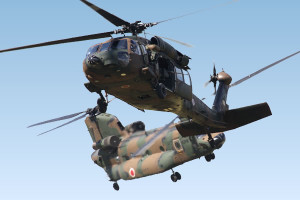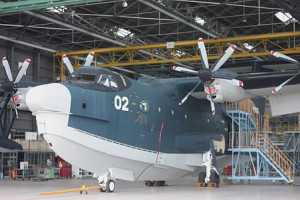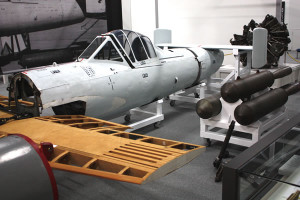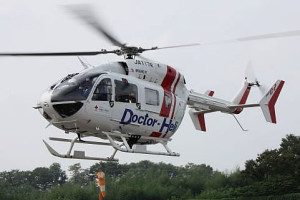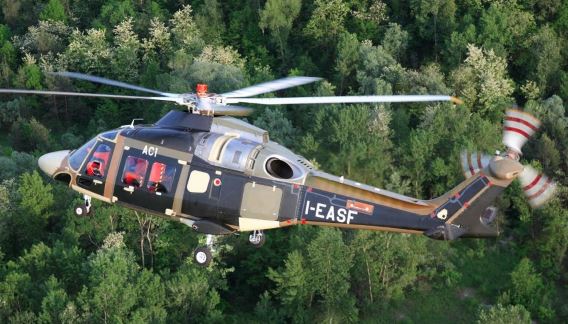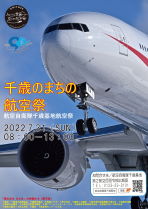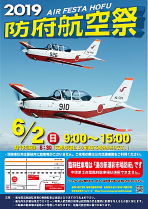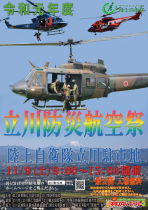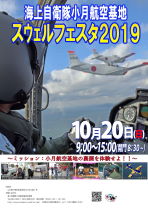JGSDF Aircraft Roll Call
JGSDF AIRCRAFT IN-SERVICE DATES IN CHRONOLOGICAL ORDER
| Aircraft Type | In Service | No. | Notes |
| T-34A Mentor | 1954–1982 | 9 | |
| Cessna L-19 variants | 1954–1986 | 129 | |
| Piper L-21B | 1954–1965 | 62 | |
| Stinson L-5 variants | 1954–1958 | 39 | Exact number unknown |
| Kawasaki KAL-1 | 1954–1964 | 1 | |
| H-13 variants | 1954–1982 | 131 | |
| H-19C | 1954–1976 | 31 | |
| Fuji LM-1 | 1956–1983 | 27 | |
| Vertol V-44A | 1959–1969 | 2 | |
| UH-1B | 1963–c.1993 | 90 | |
| Kawasaki KAL-2 | 1964–1966 | 1 | ex-JASDF |
| KV-107II | 1966–2002 | 60 | |
| LR-1 (MU-2B) | 1967–2016 | 20 | ff. May 11, 1967 |
| OH-6J | 1969–c.1994 | 117 | |
| TH-55J | 1972–1995 | 38 | |
| UH-1H | 1973–2017 | 133 | |
| AH-1S Cobra | 1979– | 92 | |
| OH-6D | 1979–2020 | 193 | |
| TL-1 (Fuji KM-2) | 1981–1990 | 2 | → JMSDF |
| AS332L1 | 1986–2006 | 3 | |
| CH-47J | 1986– | 34 | |
| UH-1J | 1993– | 130 | |
| Kawasaki OH-1 | 1997– | 38 | ff. (XOH-1) Aug. 6, 1996 |
| UH-60JA | 1998– | 40 | ff. Aug. 19, 1997 |
| CH-47JA | 1998– | 39 | (Plus 12 in FY2024 budget) |
| Beechcraft LR-2 | 1999– | 9 | Ninth aircraft arr. Nov. 2020 |
| AH-64D Apache | 2006– | 13 | |
| EC225L | 2006– | 3 | |
| TH-480B | 2011– | 30 | ff. (in Japan): Feb. 4, 2011 |
| V-22B | (On order) | 17 | First two arr. May 2020, 17th in service late 2023 |
| UH-2 | (On order) | (71) | Ninth being test flown Feb. 2024 |
LATEST TYPE RETIREMENT
In early 2020 still operated by the 3rd, 4th, 8th, 10th and 13th AvSqns, the 102nd Sqn as well as the HQ Flight of the 12th Helicopter Squadron, which flew the last mission, the OH-6D was officially withdrawn from service on March 31.
 Never to be seen again. A lineup of 10th and 13th AvSqn OH-6Ds at the November 2019 Akeno
Never to be seen again. A lineup of 10th and 13th AvSqn OH-6Ds at the November 2019 Akeno
air show, the last to feature them before the type’s retirement. (Photo: JGSDF/10th AvSqn)
According to a report in the June 2020 issue of Kōkū Fan magazine, 17 OH-6Ds had newly arrived to join those that have long since been awaiting their fate on “death row” in a Kasumigaura hangar. After the removal of reusable items of equipment, a few will be used for instructional purposes or placed on display, but the majority will be either sold or scrapped. At the time of writing (April 2020), of the 193 OH-6Ds built a total of around 65 remain scattered around the country.
During the type’s service career, a total of 12 aircraft were lost in accidents. The first occurred on May 30, 1983, the last on April 16, 2015, when the tail unit was severed during an emergency landing in a rice paddy in the Miyagino district of Sendai, Miyagi Prefecture. The aircraft had been on post-maintenance test flight; the pilot and a maintenance team member escaped uninjured. Half of the losses came as the result of midair collisions: on two occasions (July 10, 1987, and March 7, 2002) between two OH-6Ds; on another (February 14, 2001) with an AH-1S; and on yet another (August 21, 1997) with a civilian light aircraft. These four incidents alone tragically claimed the lives of 12 OH-6D crew members.
 The tail marking of this OH-6D denoted an aircraft assigned to the
The tail marking of this OH-6D denoted an aircraft assigned to the
1st Division’s 1st AvSqn at Tachikawa.
Those still with the JGSDF include six at Kita-Utsunomiya Aviation School formerly used for pilot ground training and maintenance instructional airframe purposes, the latter being a role for which some might yet receive a stay of execution. The type is popular as a gate guardian and around 14 are on display at JGSDF army camps at which there is no based aviation unit.
Aside from one privileged example retained by licensed manufacturer Kawasaki, a number of others have been acquired for technical training purposes at aeronautical colleges or loaned for display in public parks and even nursery schools. As listed on the JGSDF Where Are They Now? page, some are composite aircraft that have been fitted with another’s tailboom.
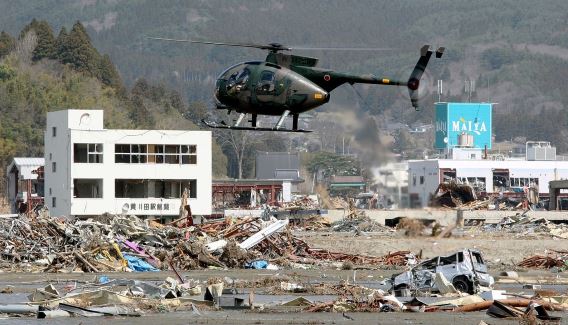 An OH-6D from the Northern Region Helicopter Squadron hovers over the scene of devastation in
An OH-6D from the Northern Region Helicopter Squadron hovers over the scene of devastation in
Rikuzentakata, Iwate Prefecture, on April 12, 2011. The building on the left was the pharmacy
near the station in the city that suffered the most catastrophic damage of any of those affected
by the March 11 tsunami. Like its sister services, the JGSDF plays a vital role as a first
responder and in ongoing rescue operations at times of natural disasters.
(Photo: Japan Ministry of Defense via Wikimedia Commons)
 JGSDF Akeno Army Camp, March 17, 2020. 10th AvSqn personnel look on as the unit’s last two
JGSDF Akeno Army Camp, March 17, 2020. 10th AvSqn personnel look on as the unit’s last two
OH-6Ds recede into the distance. (Photo: JGSDF/10th AvSq)
The Japan Ministry of Defense released figures that showed the trends in the JGSDF’s helicopter inventory over the years FY2015 to FY2019:
| FY15 | FY16 | FY17 | FY18 | FY19 | Difference | |
| AH-1S | 60 | 59 | 56 | 55 | 52 | -8 |
| CH-47J/JA | 58 | 57 | 56 | 55 | 53 | -8 |
| OH-6D | 48 | 44 | 27 | 26 | 14 | (wfu) |
| UH-1J | 131* | 131* | 127 | 127 | 124 | -6 |
| UH-60JA | 39 | 40 | 40 | 40 | 40 | +1 |
* Including one UH-1H
The OH-1 inventory has hovered at a steady 37 aircraft, the AH-64 at 12.
(Photos [UH-2/UH-60JA at Akeno Nov. 2023, OH-1 Yao Nov. 2022]: ヒロ via X @HiroRjoy)
JGSDF Aircraft Programmes
This section primarily provides general status overviews by type of those aircraft that are currently being procured or for which funding is being sought:
Bell-Boeing V-22B Osprey
Kawasaki-Boeing CH-47JA Chinook
SUBARU UH-2 Hayabusa (UH-X)
 (Photo [Fuji live firing range, August 2019]: Japan Ministry of Defense)
(Photo [Fuji live firing range, August 2019]: Japan Ministry of Defense)
The budget system employed by the Japan Ministry of Defense calls for equipment requests for the following fiscal year (FY) to be submitted to the government in August and approved in December. The fiscal year runs from April 1 of that year to March 31 of the following year.
For the purposes of longer term planning, the Cabinet approves a five-year Medium-Term Defense Program (MTDP). Passed on December 18, 2018, the current MTDP runs from FY2019 to FY2023 and, in the JGSDF’s case, envisaged the procurement of 34 UH-2s and three CH-47JAs.
Current Aircraft Procurement
Bell-Boeing V-22B Osprey
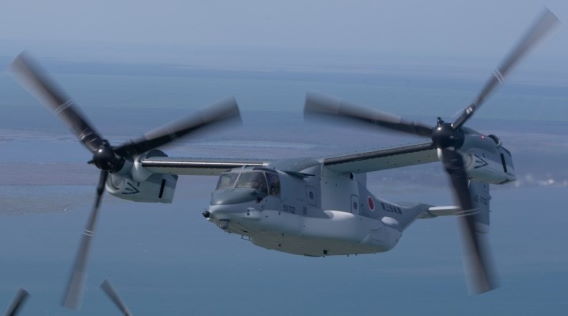 One of the first two JGSDF V-22B Osprey tiltrotors during training conducted with U.S. Marine
One of the first two JGSDF V-22B Osprey tiltrotors during training conducted with U.S. Marine
Medium Tiltrotor Training Squadron 204 (VMMT-204) MV-22s from MCAS New River,
North Carolina. (Photo [July 2019]: U.S. Marine Corps/Lance Cpl. Elias E. Pimentel III)
The Japan Ministry of Defense announced its selection of the V-22 Osprey on November 21, 2014.
The previous MTDP, which ran until FY2018, foresaw the introduction of 17 tilt-rotor aircraft in connection with the formation of an amphibious, rapid deployment brigade. Although not specified at the time of that MTDP’s announcement, all the signs since then left little doubt that the Osprey would be selected. In the end, the defence budget announced on January 14, 2015, included funding for an initial buy of five of the type. This was followed by the approval of four of the additional 12 requested as part of the FY2016 budget. Not surprisingly, the 1.32 billion yen originally allocated was the only funding earmarked for JGSDF aircraft purchases.
There is a sense of irony that the Osprey, which has found itself caught in the downwash of controversy concerning the U.S. military presence in Okinawa in particular, will be entering the JGSDF’s ranks. In July 2012, the USMC deployed an Osprey unit to MCAS Futenma via Iwakuni, Yamaguchi Prefecture. Due to its initially poor safety record, the Osprey became the subject of at times vociferous local protests even before its arrival at Futenma, where a USMC CH-53D had crashed onto a university campus, fortunately outside of term time, in 2004. Accidents involving a U.S. Air Force HH-60G Pave Hawk in Okinawa and an U. S. Navy MH-60S Knighthawk close to Yokosuka naval base, in August and December 2013, respectively, provided the opposition’s argument with extra ammunition.
In July 2014, the Osprey thus made its charm offensive debut in Tokyo when a pair of USMC aircraft stopped at Yokota AB en route to static display at an air show in Sapporo, Hokkaido Prefecture. In August, Ospreys were back at Yokota AB to take part in a disaster relief drill and, amid more protests in mid-October, in a tsunami response exercise in Wakayama Prefecture, during which they were operated without incident from the JMSDF helicopter carrier Ise. The first demonstration flight of an Osprey at an air show in Japan was at Nyutabaru air base, Miyazaki Prefecture, in December 2013.
During a visit to the United States in July 2014, the then Japanese Defence Minister Itsunori Onodera arrived at the Pentagon aboard an Osprey operated by the presidential support flight, and not for nothing was an Osprey present when Prime Minister Shinzō Abe visited Hyakuri AB for the SDF review in October. At the grass roots level, JGSDF troops have already been airlifted by Ospreys during joint exercises, as shown in the photograph from October 2013 below.
The December 2014 issue of JWings magazine quoted U.S. data from 2012 released by the Japanese Ministry of Defense. The data showed that the USMC’s MV-22B’s accident rate was better than other USMC types, including the CH-46E Sea Knight the Osprey had replaced at Futenma, and the accident rate for Japanese civil-operated helicopters.
Hand in hand with the prospect of the JGSDF operating the Osprey came the added considerations and expense of the development of dedicated air base and support facilities for the amphibious brigade. The USMC has made use of underutilized Saga airport in northern Kyushu for training and ferry purposes, but a Japanese suggestion to ultimately co-locate both services’ Ospreys there was dismissed as operationally impractical by the U.S. side in August 2014.
Soon afterwards, buoys off Camp Schwab in Okinawa marked out an area that, when reclaimed, is set to ultimately become the site of a new USMC air base. Although seemingly a step toward easing the burden on the residents around Futenma, this plan has also came up against opposition on environmental grounds and been firmly in the sights of the staunchly anti-base former Governor of Okinawa Takeshi Onaga, who was voted in on November 16 and assumed office on December 10, 2014.
The details of the JGSDF’s Osprey eyrie had then yet to be ironed out, but the first base to receive an example when deliveries of the type commenced, which was planned for September 2017, was presumed be the Experimental Flying Unit at Akeno, Mie Prefecture.
Published in January, the March 2016 issue of Kōkū Fan mentioned that the JGSDF still had plans to base 20 Ospreys at Saga airport, along with the around 50 helicopters currently at nearby Metabaru. It remains to be seen how JGSDF operations would be dovetailed with those of what, following a ceremony held on January 16, 2016, is now the renamed Kyushu Saga International Airport.
The increased emergency airlift capability that the Osprey will provide the JGSDF, not to mention on occasion sections of the Japanese population, was ably demonstrated in November 2013. Futenma-based MV-22B Ospreys were able to fly non-stop with heavy loads of all-important initial relief supplies to the area of the Philippines left devastated by Typhoon Haiyan.
On February 1, 2017, the U.S. Marine Corps announced that the first JGSDF pilot had commenced training on the Osprey with VMMT-204 at MCAS New River, North Carolina. Captain Tomohirō Sato was destined to be an instructor pilot with the unit that at that time was still scheduled to form at an as yet unnamed JGSDF camp at Saga Airport in FY2018.
In late August 2017, the first Osprey destined for the JGSDF, a V-22B Block C aircraft equivalent to the USMC’s MV-22, was sighted at the Bell Helicopter Assembly Center in Amarillo, Texas, shortly before its first flight [link].
Also in August, Japanese news media were reporting that opposition to Ospreys being operated from Saga airport—primarily from the fishing cooperative that owns the land earmarked for development—might dictate that the much-maligned aircraft be assigned to a JGSDF camp in Kyushu instead. Although any decision was then still very much up in the air, Kyushu would be operationally preferable to the fallback plan of the far-off but wide-open spaces of Kisarazu on the coast of Chiba Prefecture.
Fast forward to early 2020, and the JGSDF newly formed a Transport Aviation Group at Kisarazu on March 26, 2020, in anticipation of the arrival of the first two aircraft (91701/05) in the summer. (See Bulletin Board story for May 8, 2020.) The next five (91702-04/07/08), were en route to Japan by ship in late January 2021 and arrived at Iwakuni on February 14, the eighth and ninth aircraft a year later.
 (Photo [Iwakuni port, May 8, 2020]: U.S. Marine Corps/Sgt. Akeel Austin)
(Photo [Iwakuni port, May 8, 2020]: U.S. Marine Corps/Sgt. Akeel Austin)
 Two milestones in the V-22 programme that were passed in 2020. The conclusion of training with
Two milestones in the V-22 programme that were passed in 2020. The conclusion of training with
VMMT-204 in the United States in June (above), and the commencement of full-fledged flight
operations outside the confines of Kisarazu, which was marked by a ceremony on November 3.
 (Photos: JGSDF 1st Helicopter Brigade via Twitter @1st_helb)
(Photos: JGSDF 1st Helicopter Brigade via Twitter @1st_helb)
 One of the first pair of JGSDF Boeing V-22B Ospreys delivered to the newly formed Transport
One of the first pair of JGSDF Boeing V-22B Ospreys delivered to the newly formed Transport
Helicopter Group at Kisarazu in July 2020. This photo was taken on November 9, 2020,
the day hovering trials commenced within the base perimeter.
(Photo: 1st Helicopter Brigade, JGSDF via Twitter @1st_helb)
 The third batch of Ospreys, the eighth and ninth aircraft to be delivered, were offloaded at
The third batch of Ospreys, the eighth and ninth aircraft to be delivered, were offloaded at
Iwakuni on February 23, 2022. (Photo: U.S. Marine Corps/Lance Cpl Calah Thompson)
Bell-Boeing V-22B Osprey Procurement
| FY2015 | FY2016 | FY2017 | FY2018 | Total | |||||||
| 5 | 4 | 4 | 4 | 17 |
Kawasaki-Boeing CH-47JA Chinook (JGSDF)
The 80th JGSDF Chinook when CH-47J procurement is included, the 30th CH-47JA first flew on January 16, 2014. The 32nd CH-47JA was being flight tested in late September 2015, and the service’s 38th and 39th CH-47JAs were scheduled for delivery in March 2022.
Rather than new aircraft, the unsuccessful FY2015 budget request included funding for the “restoration” of three CH-47J helicopters, one of which had been agreed to in the two previous fiscal years.
On January 17, 2015, it was announced that the JGSDF was planning to base four CH-47Js and 100 support personnel at a sub-base co-located with JASDF Miho, Tottori Prefecture, from FY2017/18. The Japan Ministry of Defense announced on December 18, 2015, that funding for an additional CH-47JA funding would be earmarked under the FY2015 supplementary budget to provide enhanced cover for disaster relief.
Despite the inclusion of big-ticket V-22 tiltrotors in the fiscal 2017 budget request announced as usual in August 2016, the JGSDF successfully sought the bulk purchase of the six new CH-47JAs listed in the MTDP under FY2017 funding; the first three of which were expected to be delivered in FY2021, the remaining three in FY2022. Whereas previous aircraft have been equivalent to the U.S. Army’s CH-47D specification, these six switched to the CH-47F variant.
On January 17, 2017, KHI delivered its 100th Chinook, a JGSDF CH-47JA. Since 1986, the JGSDF has received 69 of those 100 aircraft, the JASDF the remaining 31.
The JGSDF bolstered its heavy-lift capabilities in the Osaka area by adding a Chinook-equipped 3rd Flight to the Central Region Helicopter Squadron in March 2018.
Kawasaki-Boeing CH-47JA Chinook Procurement
since FY2009
| FY09 | FY10 | FY11 | FY12 | FY13 | FY14 | FY15 | FY17 | FY20 | FY24 | Total |
| 4 | 1 | 1 | 2+1* | 1** | 1** | 3 / 1 | 6/6 | 3/3 | 12 | 33 |
(*) Additional aircraft funded from supplementary budget.
(**) Funding was one “restoration” in each of FY2013 and FY2014.
Notes: (FY2015) No main budget funding received for three aircraft requested; funding for one additional aircraft under supplementary budget.
(FY2017) All six requested to be procured ; (FY2018, FY2019 and FY2021 to FY2023) None funded
SUBARU UH-2 Hayabusa (formerly UH-X Utility Helicopter Requirement)
In contrast to the speed of the TH-480B deliveries, the JGSDF has been drip fed 130 UH-1Js since 1993, continuing a process that was started with the first of 90 now long since retired UH-1Bs in 1963 and followed with the first of 133 UH-1Hs in 1973. At the end of March 2014, the Ministry of Defense stated that its combined UH-1H/J inventory stood at some 141 helicopters; some UH-1Hs remain in store or are used as instructional airframes.
That gives you some idea of the numbers of helicopters involved in this requirement. Had things been different, the JGSDF would have been looking ahead to accepting delivery of the first UH-X in 2017, as Kawasaki Heavy Industries (KHI) was awarded a contract in March 2012.
At that time, an artist’s impression of Kawasaki’s winning design revealed a standard UH-1J-class utility helicopter configuration for two crew and 11 personnel, with certain design elements—side-mounted engine intakes, Fenestron tail rotor—adopted from the company’s OH-1. All was left in the hover in 2013, however, after it transpired that JGSDF officials had leaked bid information to KHI. The only other company in contention had been Fuji Heavy Industries (FHI), the JGSDF’s 40-year legacy provider of the three UH-1 variants.
This time around, the early indications were that a wide-open field would be entered in the race to win the development contract and a decade’s worth of deliveries valued at around $2 billion. Lined up waiting for the issuance of a formal request for proposals were teams of Japanese and overseas manufacturers, the Ministry of Defense having announced in April 2014 its plans to select a modified, commercially available helicopter to fulfill the requirement.
On February 25, 2015, the Equipment Procurement and Construction Office at the Ministry of Defense issued a synopsis of the request for proposal guidelines for those companies wishing to bid for the UH-X contract. This called for one helicopter to have been delivered by March 30, 2020. A briefing for interested parties was scheduled for March 9, and the deadline for manufacturer’s proposals set at June 2.
An old adage once said that the only replacement for a DC-3 is another DC-3. In the helicopter world, Bell Helicopter Corp. and FHI was proved correct in hoping that the Japan Ministry of Defense would think that could be said of Hueys as well. The Bell 412EPI was selected as the base airframe in July 2015, and then FHI, which was to change its name to SUBARU in April 2017, announced the conclusion of a prototype development contract on September 2 that same year. The Bell 412 and 412EP are well represented in the skies over Japan, including with the Japan Coast Guard and prefectural rescue services (photo below). First introduced onto the market in March 2013, the latest 412EPI version offers equipment fit and performance improvements.
In recent years, European companies have made deep inroads into the Japanese helicopter market. One such is AgustaWestland, which secured Japan Coast Guard orders for its AW139 with the assistance of its distributor, the trading company Mitsui & Co., rather than a Japanese manufacturer. On paper an ideal fit in this case would have been the AW169, the prototype of which (see photo below) first flew in May 2012, coincidentally soon after the failed first contract was placed with KHI.
KHI had been set to team up with Airbus Helicopters, which as Eurocopter recorded a volume of orders in the Japanese market sufficient for the setting up of a dedicated maintenance facility in Kobe, Hyogo Prefecture. Trumpeted as a “clean-sheet” design, the partnership’s submission would nonetheless have drawn on Airbus Helicopters’ newly developed H160 platform rather than the militarized version of its EC145 that was selected from among five proposals by the U.S. Army as the UH-72A Lakota. In the final analysis, the Bell 412EPI-based helicopter won out in terms of its assessment under the requirement’s performance, logistical support, development feasibility and delivery lead time criteria. The first of around 150 aircraft was then due to enter service in 2021.
The March 2019 issue of Kōkū Fan reported that the first UH-X (45001, now 45151) had hovered for the first time on December 21, 2018, and first flown four days later, on Christmas Day. An initial buy of six was included in the FY2019 budget and a further seven requested and approved under FY2021 funding. These were followed by 13 each under the supplementary FY2021 budget and the FY2023 budget, making a total of 39 on order. To these were added 16 aircraft under both FY2024 and FY2025 funding, raising the total to 71.
 A Shinto priest waits to perform the traditional purification ritual on the XUH-2 prototype
A Shinto priest waits to perform the traditional purification ritual on the XUH-2 prototype
on the occasion of its handover at SUBARU’s Utsunomiya Plant, February 28, 2019.
(Photo: JGSDF via X [formerly Twitter] @JGSDF_pr)
 March 8, 2019. The XUH-2 is delivered to Akeno for a roughly year-long test programme with
March 8, 2019. The XUH-2 is delivered to Akeno for a roughly year-long test programme with
the Experimental Flying Unit, after which full-scale operations on the type would begin there.
(Photo: JGSDF Aviation School, Camp Akeno via Wikimedia Commons)
It was on June 24, 2021, that the Ministry of Defense announced the end of UH-X development testing and the start of operations as the UH-2.
 Its serial changed from the 45001 to 45151, the prototype UH-2 is put through its paces
Its serial changed from the 45001 to 45151, the prototype UH-2 is put through its paces
at the Cape Sata live firing range in Kagoshima Prefecture, July 2021.
(Photo: いちぶちゃー via X [formerly Twitter] @okadna35)
 First flown on May 19, 2022, the first production UH-2 (41512) was handed over at
First flown on May 19, 2022, the first production UH-2 (41512) was handed over at
Utsunomiya on June 30, 2022. (Photo: JGSDF via X [formerly Twitter] @JGSDF_pr)
 Akeno, July 13, 2022. Both aircraft were present at the ceremony to mark the start of UH-2
Akeno, July 13, 2022. Both aircraft were present at the ceremony to mark the start of UH-2
Hayabusa maintenance training. Their first formation flight took place on August 5 that year.
 (Photos: JGSDF Camp Akeno via X [formerly Twitter] @CampAkeno)
(Photos: JGSDF Camp Akeno via X [formerly Twitter] @CampAkeno)
The type by now being referred to as the Hayabusa, the third production example (45154) was delivered to the JGSDF Aviation School at Kasumigaura for maintenance training on September 13, 2022. Back at Akeno, pilot training commenced on the UH-2 in January 2023 UH-2, the flights using the call-sign Harrier. Seven aircraft were flying from March 2023.
 May 27, 2023. UH-2 45152 makes the type’s debut at the annual live-fire exercise at the Fuji
May 27, 2023. UH-2 45152 makes the type’s debut at the annual live-fire exercise at the Fuji
training ground in Shizuoka Prefecture. Having been held behind closed doors since 2020
due to the pandemic, the cost-saving decision was taken to permanently
caese the public access that had been granted since 1961.
(Photo: JGSDF via X [formerly Twitter] @JGSDF_pr)
 Minor detail. The cockpit door window frames on UH-2 production aircraft (above) differ
Minor detail. The cockpit door window frames on UH-2 production aircraft (above) differ
from those on the prototype, which seem to have come from the UH-1J spares bin.
 (Photos, via X (formerly Twitter): [Top, Tachikawa, Oct. 2023] 石津祐介(Y-Kay) @DontendonY);
(Photos, via X (formerly Twitter): [Top, Tachikawa, Oct. 2023] 石津祐介(Y-Kay) @DontendonY);
[above, Komaki, Feb. 2022] タカミュー @takamiew)
March 2024 saw the first delivery (45158) to the Central Army, followed by the 15th aircraft built (45165) to the 2nd Flight of the Western Army Helicopter Squadron in July.
Completed/Lapsed Aircraft Procurement
Enstrom TH-480B
 (Photo: JGSDF via Enstrom Helicopter Corporation)
(Photo: JGSDF via Enstrom Helicopter Corporation)
Then officially listed as the “next helicopter trainer,” the single-aircraft first buy of what was to be the Enstrom 480B (given the Japanese military designation TH-480B) was included in the FY2009 budget. The first aircraft was delivered in February 2011.
Another single aircraft was included in FY2010 before capital sanction was acquired for the bulk procurement of an additional 28 helicopters in FY2011.
Purchased by the Chinese company Chongqing Helicopter Investment Co., Ltd. (CQHIC) in late 2012, the Enstrom Helicopter Corp. successfully completed the contract. The last of the total of 30 aircraft was test flown at the JAMCO Corporation facility at Sendai in early February 2015.
 A pair of TH-480Bs from the resident Aviation School cavort during a display at Camp
A pair of TH-480Bs from the resident Aviation School cavort during a display at Camp
Kita-Utsunomiya’s 50th anniversary air show, which took place in May 2023.
(Photo: たかぽん via X [formerly Twitter] @ takapochen)
Kawasaki OH-1
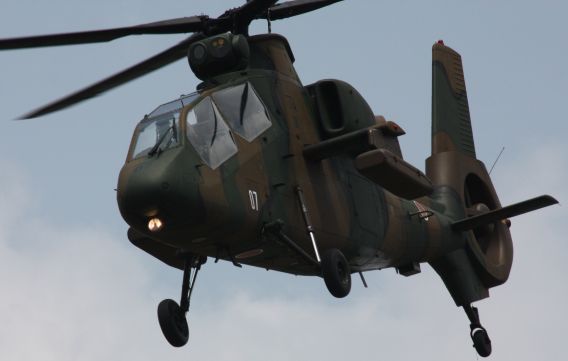 Production of the Kawasaki OH-1 ended with the delivery of the 38th and final example on
Production of the Kawasaki OH-1 ended with the delivery of the 38th and final example on
Feb. 26, 2013. Two power loss incidents in 2015 that resulted in forced landings resulted
in the entire OH-1 fleet being grounded for more than three years;
the flight ban was finally lifted in March 2019.
 The second of the four flying OH-1 prototypes, the Experimental Flying Unit’s 32062 has worn the
The second of the four flying OH-1 prototypes, the Experimental Flying Unit’s 32062 has worn the
same black and white colour scheme since its first flight, which took place on November 12, 1996,
three months after the type’s maiden flight on August 6 that year. Its serial number, however, was
changed from 32002 in 1999. (Photo: たかぽん via X [formerly Twitter] @ takapochen)
Mitsubishi-Sikorsky UH-60JA
The last of the 40 helicopters of this type budgeted for between fiscal years 1995 and 2013 was test flown at Nagoya in January 2016. The pattern of acquisition in the preceding seven years is shown in the chart below.
Mitsubishi-Sikorsky UH-60JA Procurement since FY2009
| FY2009 | FY2010 | FY2011 | FY2012 | FY2013 | FY2014 | FY2015 | Total |
| 1 | 3 | 2 | 1+1* | 1 | 0 | None | 9 |
(*) Additional aircraft funded from supplementary budget.
The Japan Ministry of Defense announced on December 18, 2015, that additional UH-60JAs would be procured under the FY2015 supplementary budget as part of funding earmarked to provide enhanced cover for disaster relief. However, the UH-60JA now appears to be losing out in the competition for funding to the V-22B and UH-2.
The following three photos show a Mitsubishi-built UH-60JA stripped down in the maintenance
hangar at Kita-Utsunomiya; the tail marking identifies the aircraft as belonging to the
1st Flight of the 12th Helicopter Unit (HU).
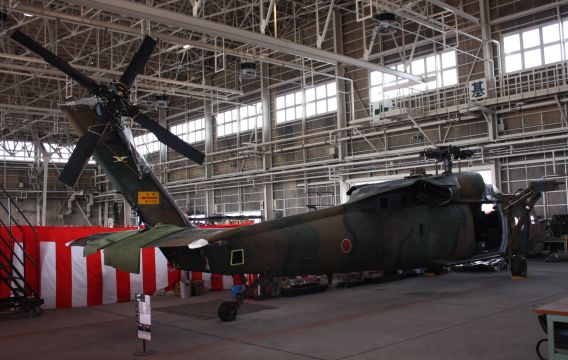


 The JGSDF received its 40th and newest UH-60JA late in 2016.
The JGSDF received its 40th and newest UH-60JA late in 2016.
(All photographs on this website are copyright J-HangarSpace
unless otherwise stated.)


